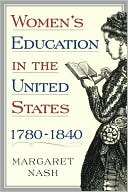

 |

|

The average rating for Origins of Women's Higher Education in America based on 2 reviews is 4.5 stars.
Review # 1 was written on 2018-02-12 00:00:00 Ishaan Misra Ishaan MisraA succinct, concise, obsessively-researched, and revolutionary little book about the secondary education available to white middle-class women in early American society, and the ways that white middle class women perpetuated class and racial divisions through middle-class educational ideologies. |
Review # 2 was written on 2009-01-01 00:00:00 David Scott David ScottThis work is a fairly comprehensive treatment of educational institutions in the US in the early national and antebellum period. Nash argues that during this period, opportunities for (white, middle-upper class women) increased dramatically, but that this increase did not correlate to improved opportunities for women in other arenas (i.e., political, economic power). Support for women's education came from many angles: the Lockians of the Enlightenment believed women's minds were tabula rasa, as men's, and that they had as much potential; evangelicals called to educated women to moralize communities, to promote true Christian charity (esp. through educating the young--not coincidentally, feminization of education occurred during this period in the North); republican ideals further called on women to be educated, as did social utility arguments (i.e., women's skills could help their husbands in business, educate sons, etc). Nash describes the rise of pedagogical interest during this period; colonial days had been characterized by rote memorization and lectures, while the new era called upon the development of the 'rational mind' through encouraging students to be active learners. Also, Nash connects the rise of educational opportunities to the forming identity of the new middling class (forming around the 1820s and 30s) and explores how the new pedagogies were particularly attentive to the development of this new class (i.e., by prizing education of the whole human: body and mind). Further, Nash suggests that if these opportunities were available at all, it was because women wanted them, because they pushed for them and demanded them: essentially it was women's love and yearning for knowledge that propelled the growth of educational institutions during this period. Limitations: since all the attention is given to formalized schooling for which documentation is available, Nash for the most part leaves out blacks and other minorities, as well as the lower classes in general. |
CAN'T FIND WHAT YOU'RE LOOKING FOR? CLICK HERE!!!